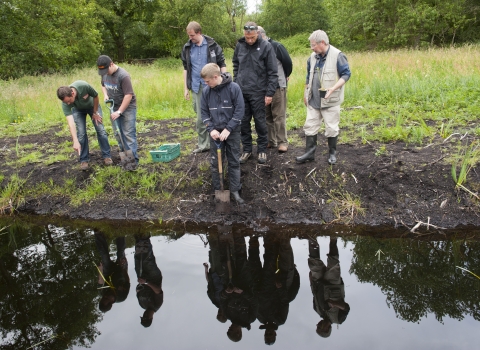What is the National Lottery?
The National Lottery – and with it National Lottery funding for good causes like heritage, arts, sport and charities – was established in 1994. Every ticket sold contributes funds to good causes across the UK.
National Lottery funding through The National Lottery Heritage Fund is one of The Wildlife Trusts most important sources of income and has helped us to achieve many amazing things for people and wildlife over the years.
About The National Lottery Heritage Fund
The National Lottery Heritage Fund is the largest dedicated funder of heritage in the UK.
Since its creation in 1994, The Wildlife Trusts have worked closely with The National Lottery Heritage Fund to connect people to nature and each other, save precious wildlife-rich places, create new woodlands, wetlands, meadows and many other habitats and protect rare and endangered species.
The National Heritage Lottery Fund has invested a total of £7.1bn in 40,000 heritage projects. The hundreds of Wildlife Trust projects across the UK supported by The National Lottery Heritage Fund have benefited thousands of people from all walks of life – helping them to experience the joy of wildlife in their daily lives; from children and young people to older generations; from those living in urban areas to those in the countryside, or by the coast.
Players of the National Lottery are helping Wildlife Trusts throughout the UK give a new lease of life to wildlife and wild places, and ignite the passions of individuals and communities to care for the wildlife on their doorstep.
Bringing People Closer to Nature
With the support of The National Lottery Heritage Fund we are helping people of all ages and background to draw inspiration and strength from wildlife and wild places. This video shows how the amazing Access, Community and Education (ACE) project, run by Nottinghamshire Wildlife Trust, is bringing people closer to nature.
Saving special wild places and threatened species
Working together within their communities Wildlife Trusts are saving special wild places and threatened species around the UK. This video of the Be There For Barn Owls project, led by Ulster Wildlife Trust, shows that people taking action for wildlife where they live and is a powerful force for change.
For information on other Natural Heritage projects, funded by The National Lottery Heritage Fund click here

How The National Lottery Heritage Fund has helped Wildlife Trusts transform places and lives
Since 1994, National Lottery players have helped every eligible Wildlife Trust (that’s 44, by the way!) right across the UK deliver over 600 projects using money awarded by The National Lottery Heritage Fund. This has helped Wildlife Trusts to work alongside volunteers and other members of the local community to transform areas ranging from city roadside verges to vast areas of land and coast. Involving local communities does not just benefit wildlife – it also helps people to reconnect with local wild places, people experience improved health and wellbeing and it helps them to help themselves and others by learning new life skills or about subjects that can help society as a whole.
Here are just a few of the projects, Staffordshire Wildlife Trust has had supported by The National Lottery Heritage Fund.
Churnet Youth project
In 2017 and 2018, young people with learning difficulties were given the opportunity to get close to nature and learn new skills at a project being run in the Churnet Valley by Staffordshire Wildlife Trust, thanks to money raised by National Lottery players.
The ‘Churnet Youth’ project, which was awarded a £26,000 grant from The National Lottery Heritage Fund, introduced youngsters to wildlife and nature conservation through practical activities while learning a wide range of skills.
The partnership project between Staffordshire Wildlife Trust and Leek College included activities at the Trust’s Rod Wood nature reserve which boasts a wide variety of habitats. Each term, the college identified groups of eight to 10 young people to participate in the project. Most of these young people had mild to moderate learning difficulties and a college tutor accompanied the groups.
Skills learnt during the project included hedge laying and coppicing, as well as developing existing skills in horticulture. They also created mini-films showing the benefits and highlights of getting involved in the project.
Shaun Rimmer, from Staffordshire Wildlife Trust, who ran the project said: “There are many well-documented benefits to increasing people's engagement in the natural environment. These include improving physical fitness, mental health and reducing stress levels. This project enabled young people to take advantage of these benefits.
“They also allowed the chance for social interaction; building confidence and self-esteem, and finding out more about the local natural heritage and how they can get involved in its conservation.”
South West Peak
The South West Peak Landscape Partnership was a group of organisations including Staffordshire Wildlife Trust, that worked to restore, protect, and improve the landscape of the South West Peak.
The partnership was formed in 2016, with the Peak District National Park Authority as lead partner and with the support of The National Lottery Heritage Fund. It was a 5-year scheme (with benefits reaching far beyond that time) that allowed work with local communities, building stronger connections with the landscape and each other. The Partnership enhanced ecosystem services, the benefits we all get from the natural environment, and supported sustainable farming in the area. You can find out more about the project here
The South West Peak Landscape Partnership used a £2.4 million National Lottery Heritage Fund grant, together with additional funding, to deliver 18 individual projects ranging from protecting the cultural resources of the area to supporting the recovery of our wading birds. A summary of each of these projects can be found in the Landscape Conservation Action Plan and as each project begins updates can be found on the Projects page.
Comprising an area of 354 square-kilometers the South West Peak contains a variety of habitats and species and includes the sources of five major river systems that supply clean drinking water to communities including Stockport, Leek, Stoke-on-Trent and Macclesfield. While there are some more well-known locations within the South West Peak, such as the Goyt Valley and the Roaches, there are also many less-known sites that local people hold dear. This partnership scheme worked to protect the natural systems around them, so that visitors and residents can continue to enjoy all that the South West Peak has to offer in a sustainable and responsible way.
Churnet Valley Living Landscapes
The Churnet Valley Living Landscape project worked to conserve, enhance and celebrate the spectacular natural and built heritage of this area. Find out more here and further reading here
The Churnet Valley Living Landscape area is situated in North East Staffordshire and spans 49,000 acres. It includes the Weaver Hills, Ipstones Edge, Biddulph Moor, Consall and Rudyard. The project received almost £2million funding from The National Lottery Heritage Fund and although led by Staffordshire Wildlife Trust, it was very much a partnership project comprising of 15 partners including local authorities, the Canal and River Trust, Destination Staffordshire, Lafarge and the RSPB.
Transforming the Trent Valley
The striking landscape of the Trent Valley, along with its archaeological and industrial heritage and important wetland habitats, have benefitted from a multi-million pound five year project.
The ‘Transforming the Trent Valley’ scheme has worked to turn people’s outlook back to the river and floodplain, raise their level of appreciation for the local heritage, and engage them in constructive and informed decision-making about the future use and management of the landscape. The scheme was a partnership of 18 organisations working together to restore and enhance the natural and cultural heritage of the Trent Valley, with Staffordshire Wildlife Trust at the helm.
The Landscape Partnership Scheme undertook a wide range of environmental, cultural and community-led projects within the Trent, Tame and Dove river valleys covering some 190 square kilometres from Uttoxeter to Tamworth and including the river valleys within or near to the main towns of Burton, Rugeley, Lichfield and Derby.
To find out more about the project visit: Transforming the Trent Valley
Nextdoor Nature
In 2022 The National Lottery Heritage Fund awarded a £5million investment in a ground-breaking initiative to create a huge matrix of community-led rewilding projects – improving the lives of people from some of the most disadvantaged areas across the UK and leaving a lasting natural legacy in honour of the Queen’s Platinum Jubilee. The funding was part of The National Lottery’s £22million investment to mark the Jubilee and was split for Wildlife Trusts around the country to run localised projects.
In Staffordshire, Staffordshire Wildlife Trust (SWT) delivered Nextdoor Nature in several areas of Stafford to give people the skills, tools, and opportunity to take action for nature. This included establishing wild habitats and green corridors in areas of economic and nature deprivation and naturalising highly urbanised or unused areas.
SWT continues to work alongside several communities in central Stafford. You can find out more on the Nextdoor Nature page here.




